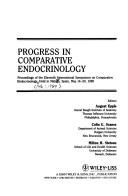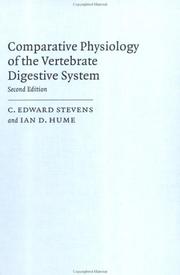| Listing 1 - 10 of 94 | << page >> |
Sort by
|
Book
Abstract | Keywords | Export | Availability | Bookmark
 Loading...
Loading...Choose an application
- Reference Manager
- EndNote
- RefWorks (Direct export to RefWorks)

ISBN: 0471568007 Year: 1990 Publisher: New York, NY : Wiley-Liss,
Abstract | Keywords | Export | Availability | Bookmark
 Loading...
Loading...Choose an application
- Reference Manager
- EndNote
- RefWorks (Direct export to RefWorks)
ENDOCRINOLOGY --- COMPARATIVE PHYSIOLOGY --- CONGRESSES --- CONGRESSES --- ENDOCRINOLOGY --- COMPARATIVE PHYSIOLOGY --- CONGRESSES --- CONGRESSES
Book
Year: 1957 Publisher: Cambridge : Cambridge university press,
Abstract | Keywords | Export | Availability | Bookmark
 Loading...
Loading...Choose an application
- Reference Manager
- EndNote
- RefWorks (Direct export to RefWorks)
Comparative physiology. --- Muscle contraction. --- Muscles. --- Physiology.
Book
Year: 2018 Publisher: Frontiers Media SA
Abstract | Keywords | Export | Availability | Bookmark
 Loading...
Loading...Choose an application
- Reference Manager
- EndNote
- RefWorks (Direct export to RefWorks)
Metabolic rate is a key ecophysiological factor determining fitness, distribution, survival and reproductive strategies of organisms. The ability to endogenously produce heat and elevate body temperature beyond ambient, has far reaching ecological implications. The diversity of thermogenic mechanisms and strategies employed throughout the animal kingdom is truly phenomenal and one of the greatest biological mysteries. Interestingly, even heat producing plants have been characterised.
Over the last several decades, the oversimplified distinction between warm- and cold blooded animals has well and truly been put to rest and the terms “endo- and ectotherm” have been established. Birds and mammals are regarded as endotherms, capable of maintaining high body temperatures within highly precise boundaries. On contrary, in ectothermic organisms ambient temperature governs body temperature and metabolism, encompassing the majority of present day species. However, it has recently become very clear that this distinction is still not accurate enough to describe the vastness of heat generating mechanisms within endo- but also ectotherms. Indeed, a plethora of ectothermic animals display endogenous as well as behavioural means of temperature control and mechanisms for heat generation. There is large diversity in regards to thermoregulatory ability and strategy within endotherms as well, with some groups being classified by separate categories such as basoendotherms and mesotherms.
Considerable interest and efforts has been put into the quest to understand the underlying physiological mechanisms leading and facilitating high metabolic rates and body temperatures of endotherms. These mechanisms are far from being exhaustively studied and the evolutionary trajectory leading to high metabolic rates and stable body temperatures is equally, vividly debated. This discussion includes an array of questions and theories surrounding the presence of endothermy in extinct dinosaurs. In addition, a lively debate surrounds the evolutionary drivers promoting the establishment of endothermy with clear support of direct or indirect selective benefits.
Within this Research Topic we plan to compile the latest ideas, knowledge and experimental work to elucidate the patterns of the evolution of endothermy and its transition/distinction from ectothermy. The focus is on key physiological mechanisms supporting this transition and contributing to the maintenance of high metabolic rates and body temperature in endotherms, as well as mechanisms for local heterothermy and heat dissipation in ectotherms. These mechanisms and conclusions may be derived from different levels of organisation such as population, taxon, species as well as tissue, cellular or molecular levels. It may also encompass novel experimental or theoretical models testing evolutionary theories of endothermy. A comparative approach is encouraged but not fundamental.
mammals --- Endothermy --- ectotherms --- heterothermy --- evolution --- birds --- thermoregulation --- comparative physiology
Periodical
ISSN: 1432136X 01741578 Year: 1984 Publisher: Heidelberg : Springer-Verlag
Abstract | Keywords | Export | Availability | Bookmark
 Loading...
Loading...Choose an application
- Reference Manager
- EndNote
- RefWorks (Direct export to RefWorks)
Physiology, Comparative --- Physiology --- Animals, Laboratory --- Periodicals --- physiology --- Physiology, Comparative. --- Physiology. --- physiology. --- Comparative physiology --- Animal physiology --- Animals --- Comparative Physiology --- Medicine, Comparative --- Zoology --- Biology --- Anatomy
Periodical
Abstract | Keywords | Export | Availability | Bookmark
 Loading...
Loading...Choose an application
- Reference Manager
- EndNote
- RefWorks (Direct export to RefWorks)
Zoology --- Physiology, Comparative --- Physiology, Comparative. --- Zoology. --- Biology --- Natural history --- Animals --- Comparative physiology --- Medicine, Comparative --- Zoology - General
Book
ISBN: 9780878933174 0878933174 Year: 2008 Publisher: Sunderland Sinauer.
Abstract | Keywords | Export | Availability | Bookmark
 Loading...
Loading...Choose an application
- Reference Manager
- EndNote
- RefWorks (Direct export to RefWorks)
Physiology, Comparative --- 591.1 --- Comparative physiology --- Medicine, Comparative --- Zoology --- 591.1 Animal physiology --- Animal physiology
Book
ISBN: 3031102568 303110255X Year: 2022 Publisher: Cham, Switzerland : Springer,
Abstract | Keywords | Export | Availability | Bookmark
 Loading...
Loading...Choose an application
- Reference Manager
- EndNote
- RefWorks (Direct export to RefWorks)
Physiology, Comparative. --- Kidneys --- Physiology, Comparative --- Physiology. --- Comparative physiology --- Medicine, Comparative --- Zoology --- Ronyó --- Fisiologia

ISBN: 0521444187 9780521444187 Year: 1995 Publisher: Cambridge ; New York, NY : Cambridge University Press,
Abstract | Keywords | Export | Availability | Bookmark
 Loading...
Loading...Choose an application
- Reference Manager
- EndNote
- RefWorks (Direct export to RefWorks)
Animal physiology. Animal biophysics --- Vertebrates --- Physiology --- Digestive organs --- Zoology and Animal Sciences. Zoology --- Zoology and Animal Sciences. Biology of Animal Taxonomic Groups --- Digestive organs. --- Physiology. --- Animal Physiology and Biochemistry --- Comparative Physiology --- Vertebrata --- Comparative Physiology. --- Vertebrata. --- Vertebrates - Physiology --- Vertebrates - Digestive organs
Periodical
ISSN: 18793029 Year: 1960 Publisher: London ; New York : [New York] : Pergamon Press, Elsevier
Abstract | Keywords | Export | Availability | Bookmark
 Loading...
Loading...Choose an application
- Reference Manager
- EndNote
- RefWorks (Direct export to RefWorks)
Physiology, Comparative --- Biochemistry --- Biochemistry. --- Physiology, Comparative. --- Biochimie --- Physiologie comparée --- Biochemie. --- Comparative physiology --- Biological chemistry --- Chemical composition of organisms --- Organisms --- Physiological chemistry --- Comparative Physiology --- Composition --- Medicine, Comparative --- Zoology --- Biology --- Chemistry --- Medical sciences --- 35.70 biochemistry: general.
| Listing 1 - 10 of 94 | << page >> |
Sort by
|

 Search
Search Feedback
Feedback About UniCat
About UniCat  Help
Help News
News